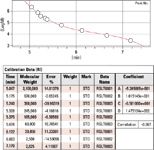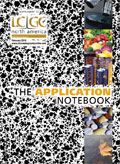Improved Reproducibility of MW Measurements of Polypeptoids Using an EcoSEC GPC System
The EcoSEC GPC System and a set of TSK-GEL mixed-bed columns, both available from Tosoh Bioscience, were used successfully for obtaining high quality MWD data of a series of block poly-β-alkylalanoids with HFIP as the mobile phase in under 15 min.
The EcoSEC GPC System and a set of TSK-GEL mixed-bed columns, both available from Tosoh Bioscience, were used successfully for obtaining high quality MWD data of a series of block poly-β-alkylalanoids with HFIP as the mobile phase in under 15 min. The apparent MW averages based of PMMA calibration ranged from 27,000 to 49,000 for Mn and from 30,000 to 61,000 for Mw with an average polydispersity of 1.20. Because of the EcoSEC GPC System's excellent flow rate and temperature control and baseline stability, average MW values ranged from 0.2 to 0.3% relative standard deviation, a ten-fold reproducibility improvement as compared to SEC literature data of polyamides using a similar mobile phase system.
There is considerable attention placed on the synthesis and characterization of polypeptoids, a new class of synthetic polypeptide analogues. One of the groups most active in this area is Dr. Li Jia and co-workers at the University of Akron (1–4) who are investigating different synthetic routes for the formation of polypeptoids with alternating block structures. Peptoids are peptide isomers that differ in the connectivity of the side chain. These polyamides are similar to polypeptides; while the side chain of the amino acid residue in a peptide is attached to the alpha carbon, the side chain of a polypeptoid is attached to the nitrogen (5). The resulting structure imparts proteolytic stability, may mimic polypeptide behavior, and could have novel polymer properties for commercial use, as they are close in structure to nylon-type polyamides.
Because of intense hydrogen-bonding among chains of these polymers, aggressive solvents must be used as the mobile phase to affect solubility. Furthermore, highly reproducible data is needed to obtain subtle molecular weight distribution trends. In view of this, an EcoSEC GPC System was used with TSK-GEL mixed-bed columns and hexafluoroisopropanol (HFIP) as the mobile phase. The EcoSEC GPC System is ideally suited for the detailed study of polymerizations owing to its high column resolution and superior instrument performance. The unprecedented reproducibility, accuracy, and RI sensitivity of this system is due to its superior design: accurate temperature control, dual-compartment oven control, newly engineered pumping system, low RI dead volume, reference GPC column, and low injection volume.
This application note presents data obtained from a series of poly-β-alkylalanoids synthesized by Dr. Li Jia, which were obtained using living alternating copolymerization of N-alkylaziridines and carbon monoxide (5).

Figure 1: PMMA calibration curve with two TSK-GEL GMHHR-M (4.6 mm ID Ã 15 cm) columns at a flow rate of 0.3 5mL/min using HFIP as the mobile phase.
Experimental Conditions
A series of block poly-β-alkylalanoids were provided by Dr. Li Jia and SEC analysis was done at Tosoh's Tokyo Research Center in Japan. Polymers were dissolved as received in HFIP at a level of 0.5 mg/mL, and passed through a 0.5 μm membrane filter. The column set used was a series of two TSK-GEL GMHHR-M (4.6 mm ID × 15 cm) columns packed in HFIP. These mixed-bed columns have a separation range of about 102 to 4 × 106. The mobile phase consisted of HFIP containing 5 mmol/L sodium trifluoroacetate to help prevent sample adsorption. An EcoSEC GPC System was used at a flow rate of 0.35 mL/min at a column and system temperature of 40 °C. Injection volume was 10 μL. A refractive index monitor was used for detection.
Calibration was based on a series of nine poly(methyl methacrylate) (PMMA) standards (American Polymer Standard) ranging in molecular weight from 2,825 to 2,100,000. A cubic fit was used for the calibration curve (correlation -0.967) (Figure 1).

Figure 2: GPC chromatogram of (A)10(B)40 block poly-β-alkylalanoid using EcoSEC GPC System with two TSK-GEL GMHHR-M (4.6 mm ID à 15 cm) columns at a flow rate of 0.35 mL/min using HFIP as the mobile phase.
Results and Discussion
Samples of block poly-β-alkylalanoids were chosen that encompassed a wide selection of different block lengths and compositions. SEC chromatograms of four representative samples are shown in Figures 2 to 5 and molecular weights summarized in Table I.

Table I: MW data of four representative samples. Apparent SEC data obtained using a PMMA calibration curve and an EcoSEC GPC System and two TSK-GEL mixed-bed columns (4.6 mm ID à 15 cm) with HFIP containing 5 mmol/L NaTFA as the mobile phase. Flow rate was 0.35 mL/min. Injection volume was 10 μL of 0.5 mg/mL sample dissolved in HFIP. An RI detector set to 40 °C was used. Samples were submitted by Dr. L. Jia (University of Akron).
(Chemical compositions of the blocks will be published in a forthcoming publication by L. Jia.) As indicated, all samples had narrow polydispersity values of 1.2, as expected from living polymerization reactions. Since PMMA was used for calibration, which has a different composition than the blocks, reported molecular weight (MW) data are relative or apparent MW, and should only be used for comparisons among samples. In fact, these values are significantly higher than calculated MW of samples computed from experimentally determined block lengths and block composition. Overestimation of MW implies that these blocks have highly extended conformations in HFIP as compared to PMMA in the mobile phase. In other words, these polypeptoids form strong hydrogen-bonds with HFIP. However, to obtain more accurate MW data, standards that are compositionally similar to polypeptoids, such as polyamide standards, e.g., nylon 66, should be used. Alternatively, an online viscometer with PMMA universal calibration or a light scattering detector should be used.

Figure 3: GPC chromatogram of (A)60(B)20 block poly-β-alkylalanoid using EcoSEC GPC System with two TSK-GEL GMHHR-M (4.6 mm ID à 15 cm) columns at a flow rate of 0.35 mL/min using HFIP as the mobile phase.
For this column set, the exclusion limit is about 1.75 mL (5 min), while the total permeation volume is close to 3.5 mL (10 min). As indicated by the chromatograms, except for (C)40 (Figure 5), these samples contain almost symmetrical, narrow polymer profiles eluting in the range of about 6 min, while residual solvents, water, and dissolved air elute in the 10 to 12 min range. There is very little tailing, and in all cases, the peak tail returns to the initial baseline with no baseline drift. This feature allows for highly reproducible data not available with conventional GPC systems. (The shoulder seen in (C)40 (Figure 5) is indicative of another population of a high MW polymer component in the sample.)

Figure 4: GPC chromatogram of (B)40(C)40 block poly-β-alkylalanoid using EcoSEC GPC System with two TSKgel GMHHR-M (4.6 mm ID à 15 cm) columns at a flow rate of 0.35 mL/min using HFIP as the mobile phase.
The MW data in Table I are averaged values from three consecutive injections of the four representative samples, along with the percent relative standard deviations of each set of three injections. The average percent standard deviations range from about 0.04 to 0.5%, with grand average of 0.3% for Mn and 0.2% for Mw. These percent standard deviations are more than 10× lower than the values reported for polyamides in HFIP mobile phase (6). Lastly, the percent relative standard deviation of polydispersities (PD) ranges from 0.1 to 0.5%, which permits one to report PDs within three significant figures. The high accuracy allows for the detailed study of polymerization reactions.

Figure 5: GPC chromatogram of (C)40 block poly-β-alkylalanoid using EcoSEC GPC System with two TSK-GEL GMHHR-M (4.6 mm ID à 15 cm) columns at a flow rate of 0.35 mL/min using HFIP as the mobile phase.
Conclusions
These apparent MW data demonstrate that an HFIP mobile phase can be reliably used with the EcoSEC GPC System for determining the MWD of polypeptoids, specifically block poly-β-alkylalanoids. In addition, these results demonstrate that the EcoSEC GPC System has unprecedented baseline and flow rate stability, as compared to using conventional HPLC systems for GPC analysis. Even with using HFIP, a toxic, strong solvent capable of dissolving polypeptoids, the grand average percent relative standard deviation of number- and weight-average MWs of a set of block poly-β-alkylalanoids, was 0.2 to 0.3%, surpassing the reproducibility using conventional HPLC systems used for SEC. This method is suitable for the study and characterization of these interesting polypeptide analogues and for the optimization of polymerization conditions for block poly-β-alkylalanoids.
References
(1) L. Jia, E. Ding, and W. R. Anderson, Chem. Commun., 1436 (2001).
(2) L. Jia, H. Sun, J. T. Shay, A. M. Allgeier, and S. D. Hanton, J. ACS, 124, 7282 (2002).
(3) J. Zhao, E. Ding, A. M. Allgeier, and L. Jia, J. Polym. Sci., Part A: Polymer Chemistry 41, 376 (2003).
(4) G. Liu and L. Jia, Angew. Chem. Int. Ed., 45, 129 (2006).
(5) L. A. Roper, D. Olson, B. Danowski, and J. D. Kehlbeck, FASEB J. 22, 1061.8. (2008).
(6) E. C. Robert, R. Bruessau, J. DuBois, B. Jacques, N. Meijerink, T. Q. Nruyen, D. E. Niehaus, and W. A. Tobisch, Pure Appl. Chem. 76, 2009 (2004).

Tosoh Bioscience LLC
156 Keystone Drive, Montgomeryville, PA 18936
tel. (215)283-5000; fax (215)283-5035
Website: www.tosohbioscience.com

SEC-MALS of Antibody Therapeutics—A Robust Method for In-Depth Sample Characterization
June 1st 2022Monoclonal antibodies (mAbs) are effective therapeutics for cancers, auto-immune diseases, viral infections, and other diseases. Recent developments in antibody therapeutics aim to add more specific binding regions (bi- and multi-specificity) to increase their effectiveness and/or to downsize the molecule to the specific binding regions (for example, scFv or Fab fragment) to achieve better penetration of the tissue. As the molecule gets more complex, the possible high and low molecular weight (H/LMW) impurities become more complex, too. In order to accurately analyze the various species, more advanced detection than ultraviolet (UV) is required to characterize a mAb sample.















